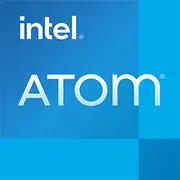Intel Atom Z2580

Intel Atom Z2580: The Moderate Giant of Ultraportable Devices
April 2025
In an era dominated by 5nm fabrication processes and neural network accelerators, processors like the Intel Atom Z2580 seem like relics of the past. However, they still find applications in niche tasks and budget devices. Let's explore why this chip remains relevant in 2025, who it is suitable for, and what its secret is.
Architecture and Fabrication Process: Minimum Resources — Maximum Efficiency
Clovertrail Code, 32nm and Two Cores
Released in 2013, the Atom Z2580 is based on the Saltwell microarchitecture, an evolution of the original Atom optimized for mobile devices. It is a 32nm chip with two cores and support for two threads (2C/2T). Its base frequency is 1.8GHz, with a temporary boost up to 2.0GHz in Burst mode (similar to Turbo Boost).
SGX 544MP2 Graphics
The integrated PowerVR SGX 544MP2 GPU is a key feature. It supports DirectX 9.3, OpenGL ES 2.0, and resolutions up to 1920x1200. At its time, it was a decent option for rendering simple 3D graphics and decoding 1080p video. However, in 2025, even basic tasks like YouTube 4K or interfaces with transparent effects may pose challenges.
Power Consumption and TDP: A Record Holder for Efficiency
The processor's TDP is only 3W, making it ideal for passive cooling. In comparison, modern Intel Core Ultra (Meteor Lake) chips in ultrabooks have a TDP starting at 9W, while the Apple M3 can reach up to 20W.
How Does This Work?
- Dynamic Voltage Management: The chip automatically reduces frequency during idle times.
- Aggressive Module Shutdown: Unused CPU and GPU blocks are completely deactivated.
- Optimization for Android/Windows: The Z2580 was often used in hybrid devices with operating systems tailored for weak chips.
Performance: Modest Capabilities for Basic Tasks
Office Work
- Documents and Browsers: LibreOffice, Google Docs, and 5-10 tabs in Chrome work acceptably but show delays when rendering complex pages.
- Example: Opening a 50MB PDF takes 3-4 seconds compared to 1 second on the Snapdragon 7c Gen 3 (2024).
Multimedia
- 1080p Video: Smooth playback in VLC or YouTube through a browser.
- 4K and HDR: Not supported natively; software decoding is required, leading to stutters.
Gaming
- Old Games: Minecraft (Java Edition) on low settings runs at 25-30 FPS.
- Mobile Ports: Asphalt 8 — 30 FPS at 720p.
- Modern Titles: Even Among Us may require reducing the resolution.
Burst Mode
The temporary increase to 2.0GHz helps with short tasks (launching apps, refreshing pages), but under prolonged load, the frequency drops back to base due to thermal limitations.
Use Cases: Who is Z2580 Still Relevant For?
1. Budget Tablets: Devices like the Lenovo Yoga Tablet 2 (2014) are still sold in the sub-$150 segment as "gadgets for grandmothers" — for Zoom calls and reading news.
2. Smart Terminals: Cash registers, infokiosks — where minimum performance and stability are required.
3. Educational Projects: Notebooks for schools in developing countries (e.g., ASUS EeeBook X205TA).
Who it won't suit:
- Gamers — even cloud gaming requires 4K video decoding.
- Designers/Programmers — compiling code or working in Figma is impossible.
Battery Life: Up to 12 Hours Without a Plug
Devices based on the Z2580 were equipped with batteries with a capacity of 25-30 Wh. In 2025, similar devices (e.g., Chuwi HiBook X with 28 Wh) provide:
- Web Surfing: 8-9 hours.
- Video: 10-12 hours (1080p, 50% brightness).
Power-Saving Technologies:
- Intel Smart Idle: Deactivates cores during idle times.
- Panel Self Refresh: Reduces GPU load with static images.
Comparison with Competitors: Who Were the Rivals?
- AMD Kabini (2013): Four cores, but 28nm and a TDP of 15W. Better in multithreading but inferior in battery life.
- Apple A7 (2013): 64-bit architecture, TDP 2W. The iPhone 5s on the A7 still outperforms Z2580 in single-threaded tests.
- Qualcomm Snapdragon 7c Gen 3 (2024): 6nm, 8 cores, TDP 5W. Three times faster in multitasking at a comparable price ($200-$250).
Strengths and Weaknesses: Why is it Still Being Purchased?
Strengths:
- Price: Devices based on the Z2580 cost $100-$180.
- Repairability: No BGA soldering — the chip can be replaced.
- Linux Support: Easy to run Lubuntu or DietPi.
Weaknesses:
- 32-bit Architecture: Many modern OSs (Windows 11, Android 14) require 64-bit.
- Limited Memory: Maximum of 2GB LPDDR2.
Recommendations for Choosing a Laptop
Types of Devices:
- Transformers: ASUS Transformer Pad TF103C ($130) — for reading and note-taking.
- Ultrabudget Laptops: HP Stream 11 ($150) — suitable only for browsing.
What to Look For:
1. RAM Size: 2GB is a minimum, 4GB (if upgradeable) is better.
2. Storage: Preferably eMMC 32GB + microSD slot.
3. Screen: IPS matrix with a resolution of 1366x768.
Conclusion: Who is Z2580 a Rational Choice for in 2025?
This processor is suited for:
- Travelers: Need a cheap device that won’t be missed if lost.
- Secondary Markets: Countries where new devices are unavailable due to sanctions or logistics.
- Enthusiasts: For experimenting with custom firmware.
Key Benefits:
- Does not require cooling.
- Operates from a power bank via USB 2.0.
- Repair costs range from $20-$30.
The Intel Atom Z2580 is an example of "digital longevity." While it doesn't fit into the mainstream, it proves that even modest chips can find their niche decades later.
Basic
CPU Specifications
Memory Specifications
GPU Specifications
Share in social media
Or Link To Us
<a href="https://cputronic.com/en/cpu/intel-atom-z2580" target="_blank">Intel Atom Z2580</a>